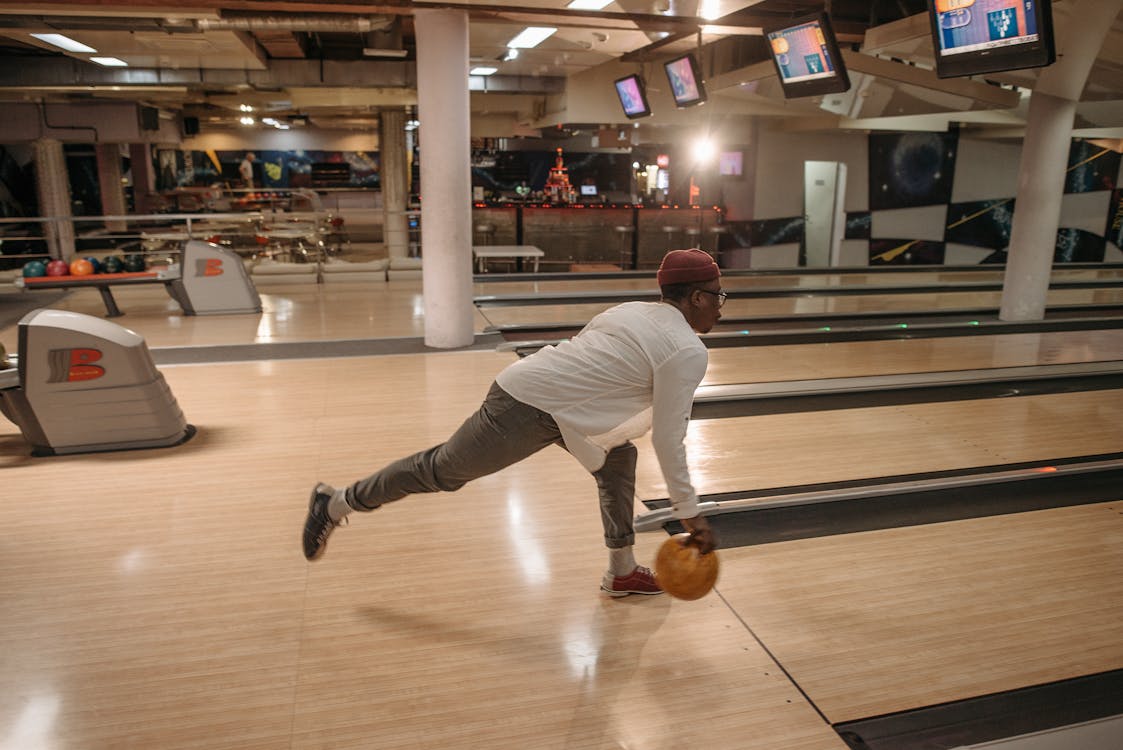How to spin a bowling ball? Bowlers who can consistently spin the ball “hook” it into the pins, whether you’ve seen a professional event at home or a casual fan who has kept up with the alley.
The ball’s rotation as it travels down the lane is referred to as “spin,” and it is largely determined by how it is released.
The ball’s rotating axis will gradually incline upward as it approaches the pins, boosting your chances of hitting them. While this isn’t the quickest approach to learning, the benefits are well worth it.
Making the Ball Spin

1. Think About How You Want To Enter The Pocket And Decide Where It Will Be
You must strike it between two other pins, referred to as the pocket. On a right-handed pinboard, the pocket is defined by the distance between the first and third pins (the pin located immediately to the right of the number 1). A left-handed user has their pocket between the first and second pins (the pin immediately to the left of the number 1).
Grip the bowling ball.
The entry angle of the ball into the hole is determined by the ball’s hook and the grip style you use. Keep in mind that if your scoring chances are improved, the greater your approach angle will be.
- Straight rolls with a smaller hook are more likely when your hand is positioned further back. If you flex your hands backward, they’ll be on top of the ball during the forward swing in this grip.
- When you hold a golf club, your thumb should be positioned to face the ground. The ball and palm should cup tightly against one another. Your forearm and thumb should appear at 90 degrees to each other when viewed from the side. This grip can generate more spin and, as a result, a greater hook.
- A midway grip creates a medium hook with a “firm” grasp. The line between your forearm and hand is straight because the wrist does not bend or flex.
2. Based On The Mix Of Pocket Position And Grip, Choose Your Stance.
Imagine three sections of the lane’s boards: outside left, middle, and outside right.
To determine the power of your grip, look down the lane and divide it into three parts: outside left, middle, and outside right.
Determine which board(s) your sliding forward foot should be aligned with to create the most hook depending on your grip strength.
Relaxed grip: Right-handed players should stand on the outside right, while left-handed players should stand on the outside left.
Firm grip: You should take a stance in the middle of the field if you want the ball to enter your desired pocket with a moderate (left or right) curve.
Strong grip: It’s critical to leave enough room for the ball to bend and enter the pocket. With your right hand on the outside of your body, you’ll be on the outside of your body with your left hand.
3. Consider How You Want To Go About Doing It Before You Start.
The most frequent form is the “Four-Step Approach.” Start by laying your feet flat on the ground and straightening your back.
Place your bowling hand on the bottom of the ball and your non-bowling hand on top of the ball to keep the ball in place while you bowl.
Keep your elbows as near your hips as possible, with your knees slightly bent and your feet aimed at the pins while executing the four steps. Your shoulders should be turned forward.
Follow these steps if you’re a right-handed bowler; if you’re left-handed, reverse the process.
- Take a step forward with your right foot and, at the same time, bring the ball to a position over your right foot. Continue to have your non-bowling hand on the ball at this stage.
- As you approach a knee-level stance, step your left foot forward and backward behind you in a half-circle. Your non-bowling hand has now released the ball at this stage.
- Take a step with your right leg and continue forward. You should be at the top of your backswing with the ball simultaneously, as well.
- When you reach the goal with your left leg, push the ball ahead. Keep your right foot behind it as you set your left foot and release the ball. Your torso should be bent forward at a 15-degree angle as you lower your hips and slightly shift your weight back while lowering yourself.
4. During The Backswing, Keep Your Arm And Wrist Straight.
The ball won’t spin if you bend or twist your wrist or arm at this stage. Instead, through good pitching and catching, you’ll impart the spin that creates a “hook.”
5. As Your Arm Swings Between The Toe Of Your Forward-Sliding Shoe And Laces, Release The Ball.
The most straightforward part is to swing your arm forward, passing the sole of your sliding shoe as you go, and then lose the ball when it reaches the laces of your shoe. There should be no problem with the ball getting into the lane during this time.
6. Make Sure Your Thumb Is The First Finger To Leave The Ball.
Your fingertips generate the spin as they let go of the ball rather than the wrist. The ball rolls off the hand because releasing the thumb first gives it the torque required for a spin.
7. At The Moment Of Release, Rotate Your Hand Slightly From The Wrist.
Bowlers benefit from a 15-degree spin (clockwise for right-handed bowlers and anti-clockwise for left-handed).
- Place your hand as if you were extending a handshake.
8. Continue With The Swing.
Continue to raise your arm and forward until the ball is released (and after).
9. Adjust As Needed Based On Outcomes
You must first develop a degree of consistency. The ability to combine all of the components and repeat them distinguishes those who succeed from those who don’t. Consider your posture, stance position, or grip style while doing it.
- In addition, practice your timing with the four-step strategy by ensuring that your foot and the ball reach the foul line simultaneously. To better understand how good your timing is, try recording it.
Conclusion

How to spin a bowling ball? Hmm, Well, It’s time to put the four-step approach to use and see how it works for you now that you know how to bowl using it. Remember to focus on your form and technique, and don’t be afraid to ask a professional for help. With enough practice, you’ll be able to refine your skills and become a better bowler.
Related Articles:





